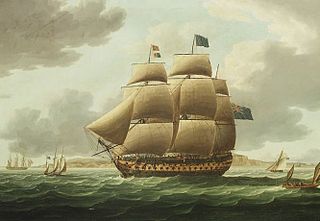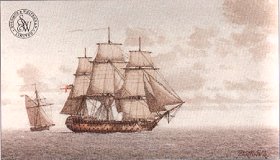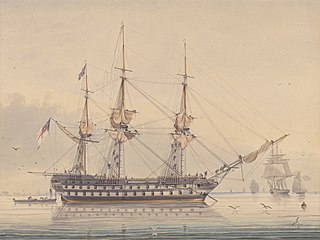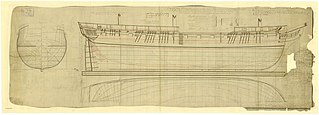
HMS Albion was a 74-gun third-rate ship of the line of the Royal Navy. She was launched at Perry's Blackwall Yard on the Thames on 17 June 1802. She was broken up at Chatham Dockyard in 1836.
HMS Ganges was a 74-gun third-rate ship of the line of the Royal Navy, launched in 1782 at Rotherhithe. She was the first ship of the Navy to bear the name, and was the name ship of her class. She saw active service from 1782 to 1811, in Europe and the West Indies.
HMS Thunderer was a ship of the line of the Royal Navy, built in 1783. It carried 74-guns, being classified as a third rate. During its service it took part in several prominent naval battles of the French Revolutionary Wars and the Napoleonic Wars; including the Glorious First of June, the Battle of Cape Finisterre and the Battle of Trafalgar.

HMS Hannibal was a 74-gun third-rate ship of the line of the Royal Navy, launched on 15 April 1786, named after the Carthaginian general Hannibal. She is best known for having taken part in the Algeciras Campaign, and for having run aground during the First Battle of Algeciras on 5 July 1801, which resulted in her capture. She then served in the French Navy until she was broken up in 1824.

HMS Ville de Paris was a 110-gun first rate ship of the line of the Royal Navy, launched on 17 July 1795 at Chatham Dockyard. She was designed by Sir John Henslow, and was the only ship built to her draught. She was named after the French ship of the line Ville de Paris, flagship of François Joseph Paul de Grasse during the American Revolutionary War. That ship had been captured by the Royal Navy at the Battle of the Saintes in April 1782, but in September of that year on the voyage to England as a prize, she sank in a hurricane.

HMS Majestic was a 74-gun third-rate ship of the line launched on 11 December 1785 at Deptford.

HMS Northumberland was a 74-gun third-rate ship of the line of the Royal Navy, built at the yards of Barnard, Deptford and launched on 2 February 1798. She carried Napoleon to his final exile on St Helena.

HMS Edgar was a 74-gun third-rate ship of the line of the Royal Navy, that saw service in the American Revolutionary, French Revolutionary and Napoleonic Wars. Launched in 1779, she fought in the battles of Cape St Vincent and Copenhagen, two of the major naval engagements of the wars.

HMS Powerful was a 74-gun third rate ship of the line of the Royal Navy. She took part in the defeat of a Dutch fleet in the Battle of Camperdown in 1797, the capture of a French privateer in the action of 9 July 1806, in operations against the Dutch in the East Indies during the raids on Batavia and Griessie in 1806 and 1807, and finally in the Walcheren Campaign during 1809.
HMS Spencer was a 74-gun third-rate ship of the line of the Royal Navy, launched on 10 May 1800 at Bucklers Hard. Her designer was the French émigré shipwright Jean-Louis Barrallier. She served in two major battles, Algeciras Bay and San Domingo, and in a number of other campaigns. She was broken up in 1822.

HMS Dragon was a 74-gun third rate ship of the line of the Royal Navy, launched on 2 April 1798 at Rotherhithe. She was designed by Sir William Rule, and was the only ship built to her draught.

HMS Venerable was a 74-gun third-rate ship of the line of the Royal Navy, launched on 12 April 1808 at Northfleet.

HMS Armada was a Royal Navy 74-gun third-rate ship of the line, launched in 1810. She was the first ship to carry the name. After a relatively undistinguished career, Armada was sold out of the Navy in 1863 and broken up at Marshall's ship breaking yard in Plymouth.

HMS Donegal was launched in 1794 as Barra, a Téméraire class 74-gun ship of the line of the French Navy. She was renamed Pégase in October 1795, and Hoche in December 1797. The British Royal Navy captured her at the Battle of Tory Island on 12 October 1798 and recommissioned her as HMS Donegal.

Étoile was a 44-gun frigate of the French Navy, launched in 1813. The British captured her in 1814 and the Royal Navy took her into service as HMS Topaze. She did not go to sea again until 1818, and was paid off in 1822. She served as a receiving ship until 1850 and was broken up in 1851.

HMS Sans Pareil("Without Equal") was an 80-gun third rate ship of the line of the Royal Navy. She was formerly the French ship Sans Pareil, but was captured in 1794 and spent the rest of her career in service with the British.

HMS Astraea was a Royal Navy 36-gun fifth rate Apollo-class frigate, launched- in 1810 at Northam. She participated in the Battle of Tamatave and in an inconclusive single-ship action with the French frigate Etoile. Astrea was broken up in 1851.

HMS Severn was an Endymion-class frigate of the British Royal Navy, launched in 1813 as one of five heavy frigates built to match the powerful American frigates. The shortage of oak meant that she was built of "fir", which meant a considerably shortened lifespan. Nonetheless, the ship saw useful service, especially at the bombardment of Algiers in 1816, before being broken up in 1825.

The Battle of Jobourg was a minor naval engagement between British and French frigate squadrons during the last weeks of the War of the Sixth Coalition in the 22nd and penultimate year of the French Revolutionary and Napoleonic Wars. In October 1813 the French Navy, unable to challenge the Royal Navy's dominance at sea, sent two small squadrons of frigates to harass British trade in the Atlantic Ocean. One was brought to battle in January 1814 and defeated near the Canary Islands but the second, from Nantes and consisting of the frigates Etoile and Sultane, fought an inconclusive engagement against British frigate HMS Severn on 4 January in the mid-Atlantic and a furious battle against HMS Astrea and HMS Creole on 23 January near Maio in the Cape Verde Islands.
Captain Edmund Palmer was a Royal Navy officer of the late eighteenth and early nineteenth century who is best known for his service as commander of the frigate HMS Hebrus, in the Battle of Jobourg off the Normandy Coast, in the last frigate ship-to-ship battle of the Napoleonic Wars on 27 March 1814. Chasing down the frigate Etoile, which was making for Saint Malo, Palmer cornered and defeated the French ship in a fierce engagement.















